In 1890 Lamberto Loria collected 45 specimens—all female—of a small bat from the wilds of Papua New Guinea. Nearly 25 years later, in 1914, the species was finally described and named by British zoologist Oldfield Thomas, who dubbed it the New Guinea big-eared bat (Pharotis imogene) after its massive ears. But no one ever saw the bat again. Some conservationists believed it had gone extinct—possibly even wiped out during that first collection—while others maintained hope. The species was categorized as Critically Endangered by the IUCN Red List, and listed as number 32 in the world’s top 100 most imperiled and genetically distinct mammals compiled by the Zoological Society of London’s EDGE program.
Fast forward to 2012. During an expedition to Papua New Guinea, PhD students Catherine Hughes and Julie Broken-Brow with the University of Queensland were busy collecting bats in a harp trap, a specially-designed stringed trap for catching bats without injuring them. After several weeks they documented nine species, and one female bat they couldn’t identify.
“But we were certain we’d stumbled upon a great discovery,” Broken-Brow told mongabay.com of the mystery female.
The pair ethically euthanized the female and placed her in the Papua New Guinea National Museum and Art Gallery. Two years later, another researcher, Harry Parnaby, requested the specimen and after careful examination discovered that the New Guinea big-eared bat was back, detailing the discovery in the Records of the Australian Museum.
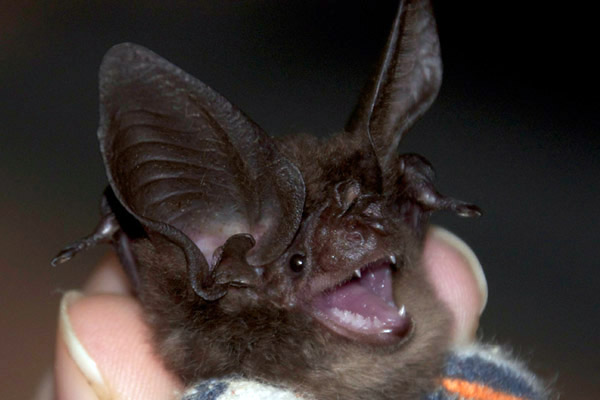
The first living New Guinea big-eared bat to be photograph. Photo by: Catherine Hughes.
“We were absolutely thrilled,” noted Broken-Brow.
Jack Stewart with EDGE said the group was also “very excited” about the discovery.
“It is extremely rare that a species that has not been recorded for such a long period of time is rediscovered and we are glad that a species so high on the EDGE mammals list is no longer considered extinct,” he told mongaaby.com, adding that the group was “very keen to assist with future conservation and research not only of the rediscovered species but across Papua New Guinea, as it contains a number of top priority EDGE species.”
Now that the researchers have confirmed that the species is not extinct, Broken-Brow says its imperative for researchers to begin learning more about this species that avoided attention for over a century.
“Nothing is known of it’s ecology or biology, only what we can assume based on it’s morphology,” she said. “We need to determine its actual distribution, habitat preferences, foraging preferences, roosting requirements and breeding cycle. Only once we know these things can we undertake active conservation. The main issue with this goal is funding, Papua New Guinea is extremely remote and costly to survey.”
Although the species is listed as Critically Endangered—and to date no male has ever been recorded—Broken Brow said it’s possible the species is more common than expected.
“The reason the species has not been found in 120 years is because no one has harp trapped in the region—ever! Harp traps are not commonly used in the tropics because they are difficult to transport and many species can simply be caught in lightweight mist nets. However, I think our survey has proven the value of lugging around a big heavy harp trap in the rainforest.”
She added that scientists should now conduct more systematic trapping for bat in different habitats in the region. Interestingly, the specimen was captured in the district of Abau on the coast, 120 kilometers east from where Loria collected his bats in 1890, meaning its range may not be too small. It was also collected from recently logged rainforest as the scientists were conducting studies on how bats fare in sustainably-managed logging concessions, in this case the Cloudy Bay Forestry Management Area.
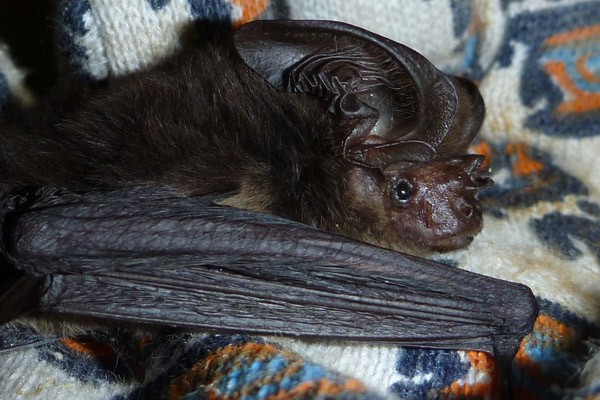
The female New Guinea big-eared bat. Photo by: Julie Broken-Brow.
“Because we have scientifically proved it’s presence, logging and development companies must now accept that there is a chance the species is present and allow for this. This will hopefully result in the protection of further habitat, not only for [the New Guinea big-eared bat], but also other species,” Broken Brow said.
However, the rediscovery also opens up a sensitive topic in conservation circles today. Recently, a study in Science argued that over-zealous collecting of endangered species could be putting them at further risk of extinction. The study, headed by Ben Minteer, argued that non-lethal technologies—such as DNA analysis, digital photography, and audio recording—should be employed instead of euthanizing animals for museum collections.
For her part, however, Broken-Brow says she doesn’t regret the decision to euthanize the female bat, saying that given the circumstances it wasn’t “unnecessary vouchering.”
“We took long and careful thought before we decided to voucher the specimen…There is certainly arguments for and against, and I fully acknowledge this. However in this case, I stick by our decision. As some readers may know, DNA is not the ‘magic solution’ for every situation. Because the previous specimens were so old (and preserved in formaldehyde) it is almost certain that DNA analysis would be extremely difficult, if not impossible,” she said, adding that photos wouldn’t have been enough either as distinguishing microbats usually depends on measuring the skulls.
“There was also a strong chance we may have discovered a completely new species to science, this also was a contributing factor to our decision,” she noted.
Finally, having a body on file means no one can dispute that the bat has been rediscovered, which Broken-Brow says could lead to more urgent conservation measures.
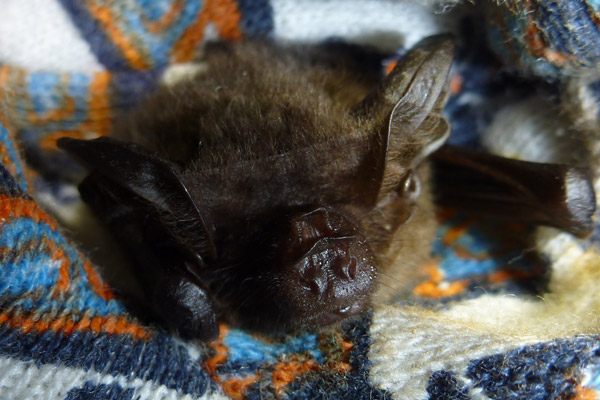
Another view of the female New Guinea big-eared bat. Photo by: Julie Broken-Brow.
“If this was one of the last individuals left in the species—I hope that its death will actually serve to save other individuals of the species, and other bat species in general. No longer can loggers [and] developers etc. pretend the bat is extinct and destroy [or] alter its habitat. They now MUST recognizes its possible presence and protect habitat for it.”
Stewart with EDGE agreed that collecting a body in this case was vital.
“It is always unfortunate that an individual of such a rare and endangered species must be euthanized however sometimes it is a necessary measure,” Stewart with EDGE added. “As the species has only been recorded once over a century ago it was important to categorically confirm that this was a New Guinea big-eared bat.”
The paper in Science, published this April, has created significant debate, including a major response paper published just over a month later. This paper, signed by 126 scientists from 66 institutions, argued for the importance of the millions of specimens maintained in scientific collections. For instance, many specimens are used hundreds of years later for data and research never-imagined by the original collectors.
One thing that can’t be disputed, however: the re-discovery of the New Guinea big-eared bat has garnered a lot of attention having been covered by dozens of media outlets.
“We are surprised at the amount of interest this has generated and it’s been great for bat awareness and conservation around the world,” said Broken-Brow, adding that “insectivorous microbats (such as Pharotis imogene) are extremely important species in any ecosystem. Microbats are found on every continent on earth, except Antarctica, and play a vital role as insect population regulators. This keeps the balance between invertebrates and plants, and also serves human interest as they control agricultural pests too.”
Citations:
- Hughes, Catherine, Julie Broken-Brow, Harry Parnaby, Steve Hamilton,
and Luke K.-P. Leung. 2014. Rediscovery of the New Guinea Big-eared Bat
Pharotis imogene from Central Province, Papua New Guinea. Records of the
Australian Museum 66(4): 225–232. - Minteer, Ben A., James P. Collins, Karen E. Love, and Robert Puschendorf. “Avoiding (Re) extinction.” Science 344, no. 6181 (2014): 260-261.
- L. A. Rocha, A. Aleixo, G. Allen, F. Almeda, C. C. Baldwin, M. V. L. Barclay, J. M. Bates, A. M. Bauer, F. Benzoni, C. M. Berns, M. L. Berumen, D. C. Blackburn, S. Blum, F. Bolaños, R. C. K. Bowie, R. Britz, R. M. Brown, C. D. Cadena, K. Carpenter, L. M. Ceríaco, P. Chakrabarty, G. Chaves, J. H. Choat, K. D. Clements, B. B. Collette, A. Collins, J. Coyne, J. Cracraft, T. Daniel, M. R. de Carvalho, K. de Queiroz, F. Di Dario, R. Drewes, J. P. Dumbacher, A. Engilis Jr., M. V. Erdmann, W. Eschmeyer, C. R. Feldman, B. L. Fisher, J. Fjeldså, P. W. Fritsch, J. Fuchs, A. Getahun, A. Gill, M. Gomon, T. Gosliner, G. R. Graves, C. E. Griswold, R. Guralnick, K. Hartel, K. M. Helgen, H. Ho, D. T. Iskandar, T. Iwamoto, Z. Jaafar, H. F. James, D. Johnson, D. Kavanaugh, N. Knowlton, E. Lacey, H. K. Larson, P. Last, J. M. Leis, H. Lessios, J. Liebherr, M. Lowman, D. L. Mahler, V. Mamonekene, K. Matsuura, G. C. Mayer, H. Mays Jr., J. McCosker, R. W. McDiarmid, J. McGuire, M. J. Miller, R. Mooi, R. D. Mooi, C. Moritz, P. Myers, M. W. Nachman, R. A. Nussbaum, D. Ó Foighil, L. R. Parenti, J. F. Parham, E. Paul, G. Paulay, J. Pérez-Emán, A. Pérez-Matus, S. Poe, J. Pogonoski, D. L. Rabosky, J. E. Randall, J. D. Reimer, D. R. Robertson, M.-O. Rödel, M. T. Rodrigues, P. Roopnarine, L. Rüber, M. J. Ryan, F. Sheldon, G. Shinohara, A. Short, W. B. Simison, W. F. Smith-Vaniz, V. G. Springer, M. Stiassny, J. G. Tello, C. W. Thompson, T. Trnski, P. Tucker, T. Valqui, M. Vecchione, E. Verheyen, P. C. Wainwright, T. A. Wheeler, W. T. White, K. Will, J. T. Williams, G. Williams, E. O. Wilson, K. Winker, R. Winterbottom, and C. C. Witt. Specimen collection: An essential tool. Science, 23 May 2014: 814-815 DOI: 10.1126/science.344.6186.814.
Related articles
The smoothtooth blacktip shark and four other species rediscovered in markets

(01/21/2014) Scientific American) magazine recently ran an article on the rediscovery of the smoothtooth blacktip shark (Carcharhinus leiodon) in a Kuwaiti fish market. Believed extinct for over 100 years, the smoothtooth had not been seen since the naturalist Wilhelm Hein returned from a trip to Yemen in 1902. With its reappearance, scientists scoured Kuwaiti markets and discovered an astounding 47 individual smoothtooth blacktips.
Not seen in over 130 years, ‘extinct’ frog rediscovered in Sri Lanka
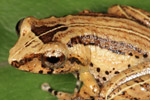
(01/10/2014) In 1876—the same year that the first telephone call was made—the British scientist Albert Günther described a new species of frog from Sri Lanka, but the species, known as the webless shrub frog (Pseudophilautus hypomelas), was never seen again. Having disappeared into history, scientists considered the species extinct—that is until a 2010 expedition stumbled on 40 mystery frogs.
Naturalist rediscovers the long-lost night parrot
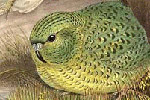
(07/16/2013) An Australian bushman and naturalist claims to have captured video footage of the night parrot, a bird not seen alive for more than a century. John Young, who describes himself as a wildlife detective, showed the footage and a number of still photos of the bird to a packed room of enthusiasts and media at the Queensland Museum on Wednesday. The desert-dwelling night parrot, Pezoporus occidentalis, has never been photographed and the only evidence of its continued existence has been two dead birds found in 1990 and 2006.
Starry frog rediscovered after thought extinct for 160 years (photos)

(03/07/2013) In 1853 Edward Frederick Kelaart, a physician and naturalist, collected a strange frog on the island of Sri Lanka then a British colony known as Ceylon. The specimen was a large shrub frog (about 2 inches or 5.5 centimeters long) with black-outlined white specks on lime-green skin. He dubbed it “starry” after its pale specks, but that was last anyone heard of it. Even the holotype—the body of the amphibian collected by Kelaart—went missing. Fast forward nearly 160 years—two world wars, Sri Lanka’s independence, and a man on the moon—when a recent expedition into Sri Lanka’s Peak Wilderness rediscovered a beguiling frog with pinkish specks.
Photo: high-altitude bird rediscovered after 80 years
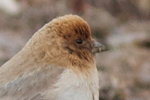
(10/29/2012) In 1929 the U.S. Stock Market collapsed, the Geneva Convention set standards for prisoners of war, the first Academy Awards was celebrated, and Jérôme Alexander Sillem collected two bird specimens on a high plateau in Xinjiang, China. For 62 years, the specimens sat in a drawer at the Zoological Museum of Amsterdam until C. S. Roselaar found them, studied them, and determined they, in fact, represented a new species of bird: Sillem’s mountain finch (Leucosticte sillemi). Now, 83 years after Sillem collected the only known specimens, a French photographer, Yann Muzika, unwittingly took photographic proof that the finch species still survives.
96 percent of the world’s species remain unevaluated by the Red List
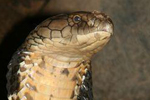
(06/28/2012) Nearly 250 species have been added to the threatened categories—i.e. Vulnerable, Endangered, and Critically Endangered—in this year’s update of the International Union for Conservation of Nature’s (IUCN) Red List. The 247 additions—including sixty bird species—pushes the number of threatened species globally perilously close to 20,000. However to date the Red List has only assessed 4 percent of the world’s known species; for the other 96 percent, scientists simply don’t know how they are faring.
Extinct toad rediscovered after hiding for 133 years in Sri Lanka

(06/18/2012) A small toad not seen since 1876, and considered by many to be extinct, has been rediscovered in a stream in Sri Lanka. First recorded in 1872, the Kandyan dwarf toad had (Adenomus kandianus) vanished for over a century before being found by scientists during a survey in 2009 in the Peak Wilderness Sanctuary, according to a new paper in Zootaxa.